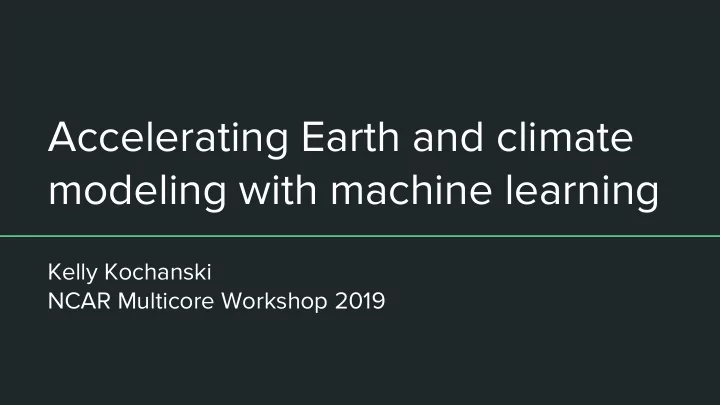

Accelerating Earth and climate modeling with machine learning Kelly Kochanski NCAR Multicore Workshop 2019
2014 xkcd.com/1425/
What is machine learning?
What is machine learning? Machine learning at its most basic is the practice of using algorithms to parse data, learn from it, and then make a determination or prediction about something in the world. Michael Copeland 2016
Why is machine learning relevant to Earth System Modeling now?
Current trends 1/3 Machine learning offers solutions to once-intractable problems
Model for Prediction Across Scales (2015), Los Alamos National Laboratory
Current trends 2/3 New data streams increase the potential power of data-driven models
Microprocessor trends Karl Rupp, World Economic Forum, 2018
Microprocessor trends Karl Rupp, World Economic Forum, 2018
9,216 Power9 22-core CPUs 27,648 NVIDIA Tesla V100 GPUs
nvidia.com
Google TensorFlow Processing Units IBM TrueNorth Chips
Current trends 3/3 Machine learning is driving innovation in HPC
My perspective: Climate change impacts ML in service of earth science
climatechange.ai
How can we use machine learning to build better Earth System Models? Image: MPAS-Ocean Los Alamos National Lab
How can we use machine learning to build better Earth System Models? Aims: ● To solve long-standing problems with new methods ● To integrate new sources of data into existing models ● To take advantage of new computing hardware
Monitoring marine clouds Yuan, Tianle, et al. "Automatically Finding Ship ‐ tracks to Enable Large ‐ scale Analysis of Aerosol ‐ Cloud Interactions." Geophysical Research Letters (2019).
Monitoring marine clouds Watson-Parris, Duncan, et al. "Detecting anthropogenic cloud perturbations with deep learning." International Conference on Machine Learning, 2019.
Improving convection + aerosol modelling
Improving convection + aerosol modelling
Improving convection + aerosol modelling Gentine, Pierre, et al. "Could machine learning break the convection parameterization deadlock?." Geophysical Research Letters 45.11 (2018): 5742-5751.
Improving convection + aerosol modelling Rasp, S, M. S. Pritchard, and P. Gentine. "Deep learning to represent subgrid processes in climate models." PNAS (2018)
Tracking extreme events Kurth, Thorsten, et al. "Exascale deep learning for climate analytics." Proceedings of the International Conference for High Performance Computing, Networking, Storage, and Analysis . IEEE Press, 2018.
Deep learning for spatio-temporal patterns Mathieu, Michael, Camille Couprie, and Yann LeCun. "Deep multi-scale video prediction beyond mean square error." (2016)
Deep learning for spatio-temporal patterns Reedster, Mogle and Bogel, ‘Monitoring and analysis of sand dune movement and growth on the Navajo Nation, Southwestern United States’ (2011) USGS Fact Sheet 3085.
Deep learning for spatio-temporal patterns Simulated example Generated frame(s)
Barriers to implementation
Barriers to implementation Machine learning Climate science What’s exciting? Big data! Science! Objectives Well-defined is useful. Broad is interesting. Explainability Second to prediction Often the main goal Data Ideally clean and labelled Many unlabeled features Data formats Images, csv, dataframes Images, netcdf, misc Data use Integral to model Data -> theory -> model Existing code Python, R, Julia C/C++, Fortran Publications At conferences In journals
Removing barriers
Building climate models that are ready to learn Schneider, T., et al. "Earth system modeling 2.0: A blueprint for models that learn from observations and targeted high ‐ resolution simulations." Geophysical Research Letters (2017)
Barriers to implementation Machine learning Climate science What’s exciting? Big data! Science! Objectives Well-defined is useful. Broad is interesting. Explainability Second to prediction Often the main goal Data Ideally clean and labelled Many unlabeled features Data formats Images, csv, dataframes Images, netcdf, misc Data use Integral to model Data -> theory -> model Existing code Python, R, Julia C/C++, Fortran Publications At conferences In journals
Creating benchmark datasets is-geo.org/benchmarks: JPL-CH4-detection-2017-V1.0 extremeweatherdataset.github.io
Barriers to implementation Machine learning Climate science What’s exciting? Big data! Science! Objectives Well-defined is useful. Broad is interesting. Explainability Second to prediction Often the main goal Data Ideally clean and labelled Many unlabeled features Data formats Images, csv, dataframes Images, netcdf, misc Data use Integral to model Data -> theory -> model Existing code Python, R, Julia C/C++, Fortran Publications At conferences In journals
Running machine-learning oriented workshops
Barriers to implementation Machine learning Climate science What’s exciting? Big data! Science! Objectives Well-defined is useful. Broad is interesting. Explainability Second to prediction Often the main goal Data Ideally clean and labelled Many unlabeled features Data formats Images, csv, dataframes Images, netcdf, misc Data use Integral to model Data -> theory -> model Existing code Python, R, Julia C/C++, Fortran Publications At conferences In journals
Next steps
Learn more about machine learning Online courses ● coursera.org/learn/machine-learning Informational blogs ● towardsdatascience.com Python tutorials ● Scikit-learn: bit.ly/sklstrata, fastai: course.fast.ai
Learn more about machine learning for Earth, weather, and climate science ● McGovern, Amy, et al. Bulletin of the American Meteorological Society 98.10 (2017): 2073-2090. Using artificial intelligence to improve real-time decision-making for high-impact weather . ● Reichstein, Markus, et al. Nature 566.7743 (2019): 195. Deep learning and process understanding for data-driven Earth system science . ● Karpatne, Anuj, et al. IEEE Transactions on Knowledge and Data Engineering (2018). Machine learning for the geosciences : Challenges and opportunities. ● Gil, Y., Pierce, S. A., ... & Horel, J. (2018). Communications of the ACM , 62 (1), 76-84. Intelligent systems for geosciences : an essential research agenda. ● Rolnick, D., Donti, P., Kaack, L., Kochanski, K., et al. arXiv preprint arXiv:1906.05433 (2019). Tackling climate change with machine learning
Make connections Climate Change AI climatechange.ai
Make connections Climate Change AI climatechange.ai Climate Informatics climateinformatics.org
Make connections _IS-GEO__ Climate Change AI Intelligent Systems and climatechange.ai Geosciences is-geo.org Climate Informatics climateinformatics.org
Make connections _IS-GEO__ Climate Change AI Intelligent Systems and climatechange.ai Geosciences is-geo.org Climate Informatics AMS Committee on AI climateinformatics.org for Env. Science
Thanks Greg Tucker, David Rolnick, Ghaleb Abdulla, Divya Mohan, Jenna Horrall, Priya Donti, Surya Karthik Mukkavilli, Barry Rountree, Goodwin Gibbons
Questions?
Recommend
More recommend